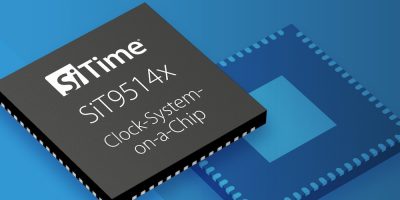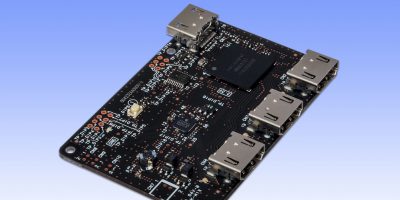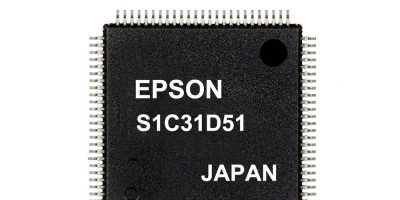The Cascade family of MEMS clock ICs have been introduced by SiTime for 5G, wireline telecomms and data centre infrastructure. The SiT9514x is a clock-system-on-a-chip (ClkSoC) family of clock generators, jitter cleaners, and network synchronisers that deliver multiple clock signals in a system. The devices use SiTime’s third-generation MEMS resonators for low power, high performance operation.
The Cascade ClkSoCs can replace clock ICs which have external quartz references, used by communications systems to integrate multiple timing functions and to distribute clock signals. The SiT9514x’s all-silicon clock architecture integrates a MEMS resonator reference inside the package.
The integrated MEMS resonator eliminates issues with quartz such as capacitive mismatch, activity dips, susceptibility to shock, vibration, and EMI, says SiTime.
Based on SiTime’s MEMS technology, the Cascade clock-SoC is claimed to deliver up to 10 times higher reliability and resilience, to enable zero downtime. This is particularly relevant for 5G networks.
5G is expected to deliver 10 times faster speeds and 10,000 times more data, with 50 times lower latency and zero downtime. To make this vision a reality, SiTime explains, 10 to 30 times more devices will be deployed, many of them in uncontrolled environments close to the consumer. Each of these connectivity gains is dependent on the accuracy, resilience and reliability of the timing heartbeat of the system. Silicon MEMS timing technology inherently provides better
Used as a standalone device or with SiTime’s MEMS TCXOs and OCXOs, the SiT9514x can be used for timing in a variety of applications such as 5G remote radio units (RRUs), small cells, edge computers, switches and routers.
The Cascade family joins SiTime’s Elite Platform Super-TCXOs and Emerald OCXOs. The Cascade devices offer a complete clock SoC which allows our customers to simplify their designs and reduce time to market. SiTime believes it is the only provider of MEMS resonators, oscillators, and clock ICs.
The SiT9514x clock SoCs feature four independent PLLs, with the flexibility to support time synchronisation applications where multiple independent clock domains are required. There are up to 11 outputs with an operating frequency range of 8kHz to 2.1GHz, as well as a one pulse per second (PPS) output, for maximum frequency agility.
The programmable PLL loop bandwidth is down to 1mHz for maximum filtering of wander or network noise in IEEE 1588 and synchronous Ethernet. Another feature is fail-safe operation in case of input clock failures through faster hitless switching between four independent inputs. In such a situation, the device automatically switches to different input clock sources with minimum phase transient at the output, allowing the downstream PLL to remain locked, and the system to continue to operate reliably
Rich programmable features and configuration options are blank in-system programmable (ISP) devices and pre-programmed versions which enable system boot up without software configuration for maximum simplicity
EVBs and TimeMaster software enable users to map clock configurations and generate the scripts for software integration, which speeds development
The SiT9514x clock-system-on-a-chip family is sampling now. High volume production quantities will be available in Q4 2020.
ICs & Semiconductors
HDMI module connects and controls to CEC standard
Based on its HDMI controller IC, the cecTalker HDMI module is designed to integrate HDMI-equipped devices, says Socionext.
The module connects, controls and links devices that have HDMI terminals, such as audio and video equipment.
It uses CEC (Consumer Electronics Control), a communication standard of HDMI to connect devices via HDMI cables. Users can integrate HDMI- compliant devices, even if they originated from different manufacturers and without the standard linkage functionalities. cecTalker can be used for PCs and supports development platforms such as Raspberry Pi, Arduino and SPRESENSE. The cecTalker module will be certified to the HDMI standard and can be used either in standalone mode or built into other products with added features and applications.
Applications include connecting audio and video equipment with smart appliances, building home IoT systems, and using video streaming services, medical imaging and industrial applications.
The cecTalker family includes the HDMI model with HDMI input and output terminals, and the V-by-One model with the added V-by-One and HDMI conversion functionality.
Both require a 5V/1A input.
Both models are currently being delivered as samples. Volume production and shipping are scheduled to start in January 2021.
Socionext designs, develops and delivers SoC solutions to customers worldwide. The company is focused on technologies that drive todayʼs leading-edge applications in consumer, automotive and industrial markets. Socionext has an extensive IP portfolio.
The company was founded in 2015 and is headquartered in Yokohama, Japan. It has offices in Japan, Asia, United States and Europe to lead its product development and sales activities.
32bit microcontroller brings sound to home, offices and industry
Microcontrollers from Epson can bring sounds to home appliances and other equipment in a variety of settings. The Arm Cortex-M0+ based S1C31D51 microcontroller has dedicated hardware which can play sound on either a speaker or buzzer.
The S1C31D51 is suitable for a variety of applications and environments. Epson says it can be used to integrate sound into home electronics, remote controllers for home appliances, industrial devices, health and fitness equipment with guidance systems, or alarms in office buildings, shopping complexes, and factories.
An Arm Cortex-M0+ processor integrated with a dedicated hardware processor provides two-channel sound on a single microcontroller chip. There is a variety of speech and audio playback functions, two-channel mixing sound (for playing background music and voice) and voice speed conversion, with a playback speed that is adjustable in five per cent increments between 75 and 125 per cent.
It is possible to output voice guidance sound like error and warning messages on a buzzer instead of a speaker. Epson says it has improved buzzer sound output performance, which can often be poor because of low volume and limited bandwidth, by using a combination of software and hardware support.
The hardware processor plays sound without requiring CPU resources, so these can be allocated to other processes even during sound playback. The use of a high data compression algorithm (16kbits per second at 15.625kHz) reduces the size of sound data memory, making it possible to provide a large amount of sound data and sound data in multiple languages.
Epson`s Voice Creation PC software tool will be provided free of charge to customers. It is a simple development environment for creating sound data for 12 languages without studio recording. Existing WAV data can also be used.
The S1C31D51 has a self- memory check function that can detect failures in built-in RAM, built-in flash, and external QSPI-flash memories without using CPU resources.
There is a variety of ways to play back sound: electromagnetic buzzer, piezoelectric buzzer and a speaker.
The S1C31D51 evaluation board includes the electromagnetic and piezoelectric buzzer by TDK that allows quick audio testing along with the pre-set demonstration.
http://www.epson-electronics.de
High Precision RV1S9353A modulator lends a hand to robotic arms
To meet the demand for high-accuracy optical isolation to improve accuracy control in industrial instruments, Renesas Electronics has introduced the RV1S9353A. It is claimed to provide best-in-class precision sensing features, including lower offset voltage drift, higher signal-to-noise ratio (SNR), lower reference voltage drift verus temperature and higher input resistance.
The optically isolated delta sigma modulator is claimed to deliver the industry’s highest accuracy compared to other 10MHz clock output optically isolated devices. It includes a precision ADC with, typically, 13.8 effective number of bits (ENOB) for converting an analogue voltage input into a digital output one-bit data stream across the isolation barrier. The RV1S9353A connects directly to Renesas’ RZ/T microprocessor and RX72M microcontroller, or other microprocessors, microcontrollers, SoCs and FPGAs with a digital filter. The RV1S9353A is used in robotic arm controllers, as well as AC servo controllers and NC servo controllers in a range of smart factory equipment.
To standardise designs during development and design certification, the RV1S9353A has 500kOhm typical input resistance making it capable of both current sensing and voltage monitoring for easier design, explains Renesas. The delta sigma modulator’s digital output and connected digital filter removes the need for complex multi-component designs that use a traditional analogue isolation amplifier with analogue filter and several other components.
Chris Stephens, vice president of communications and motor control, industrial and communications business division at Renesas, elaborates: “Its higher input resistance and ability to provide both current sensing and voltage monitoring simplifies design and saves costs while meeting the UL, CSA and VDE safety standards.”
The RV1S9353A modulator has an input offset voltage drift versus temperature (max) of 2.5 microV per degrees C and a typical SNR of 85dB. Reference voltage (max) gain error is ±0.5 per cent and typical reference voltage drift versus temperature is 30ppm per degrees C. High input resistance is rated at 500kOhm (typical) and the high common mode transient immunity is typically 25kV per micro second
The RV1S9353A is supplied in an eight-pin SDIP with 1.27mm pin pitch.
The RV1S9353A delta sigma modulator is available now from Renesas’ worldwide distributors.
About Smart Cities
This news story is brought to you by smartcitieselectronics.com, the specialist site dedicated to delivering information about what’s new in the Smart City Electronics industry, with daily news updates, new products and industry news. To stay up-to-date, register to receive our weekly newsletters and keep yourself informed on the latest technology news and new products from around the globe. Simply click this link to register here: Smart Cities Registration







